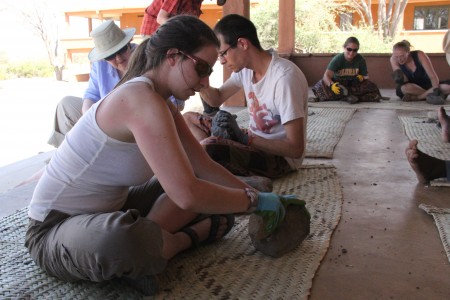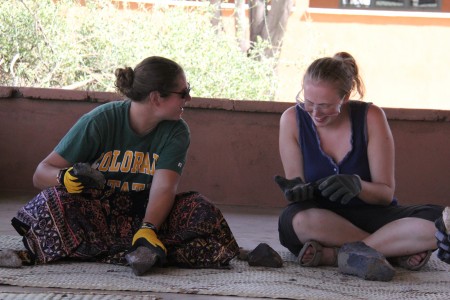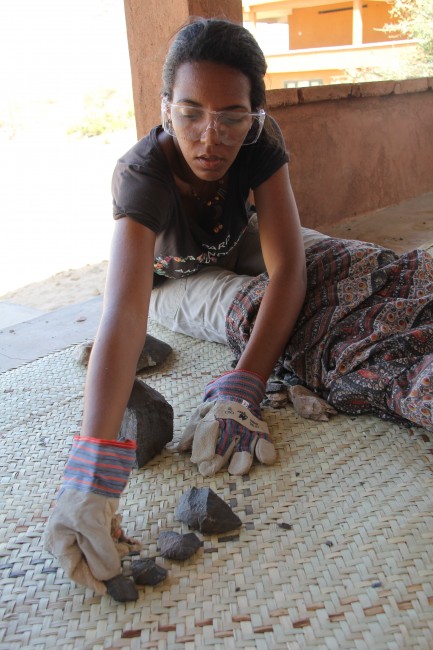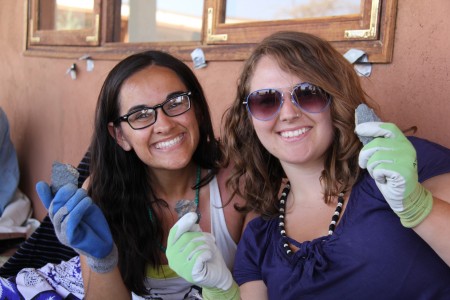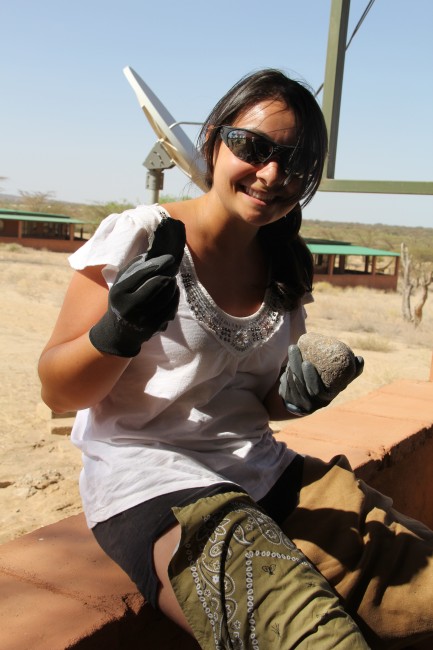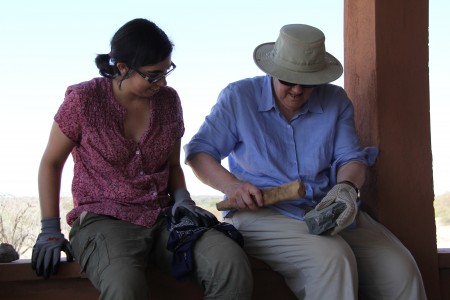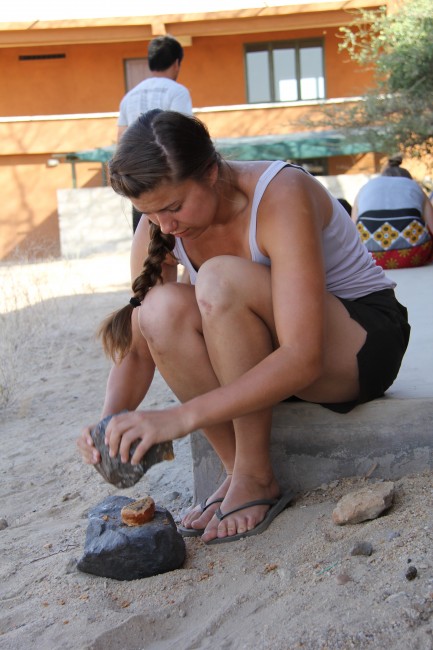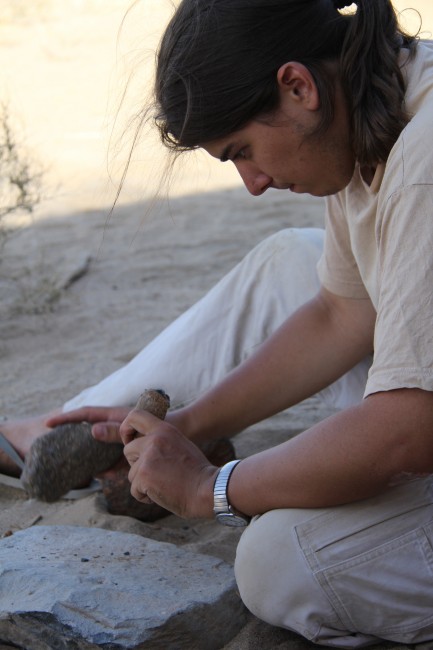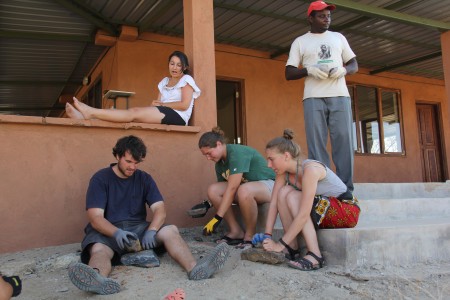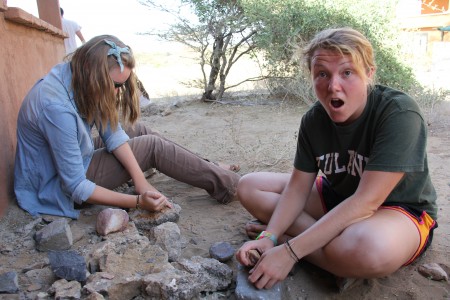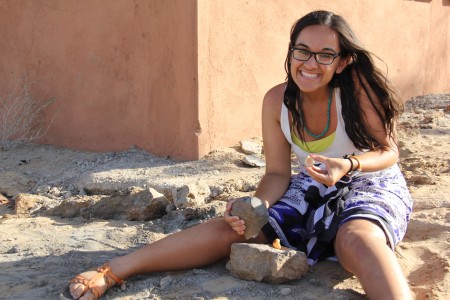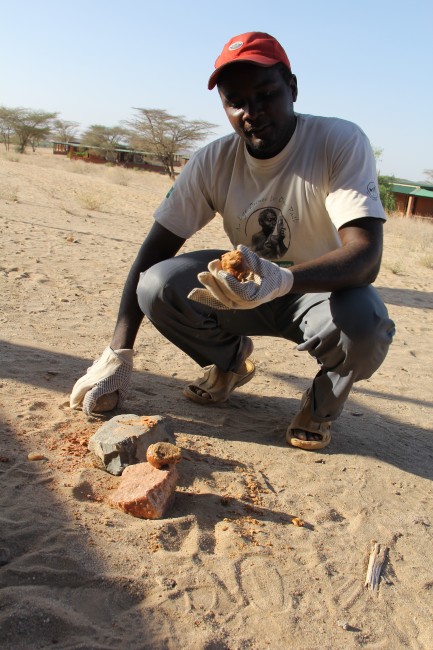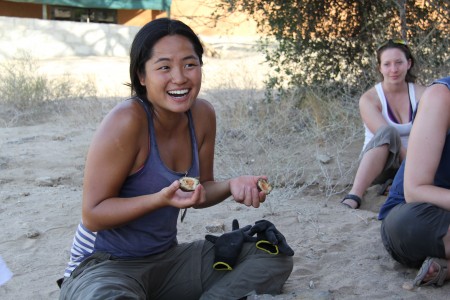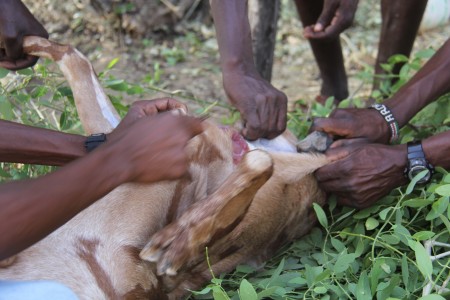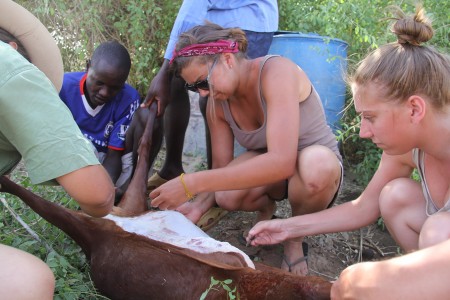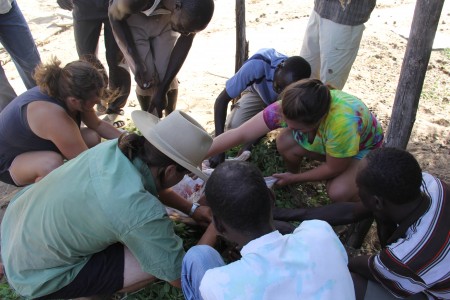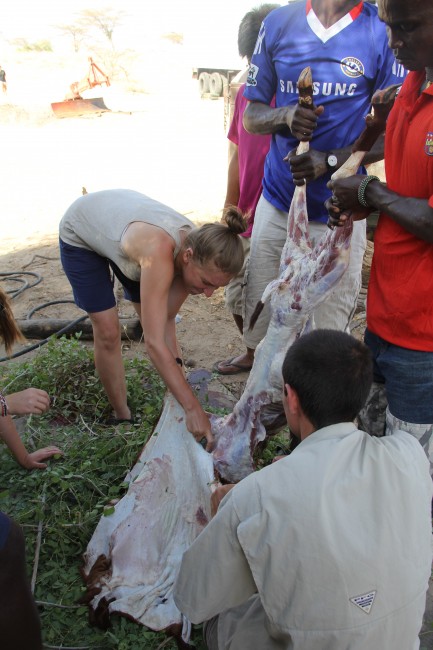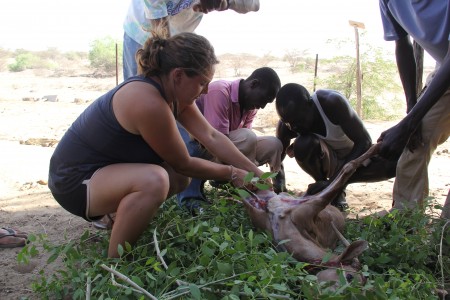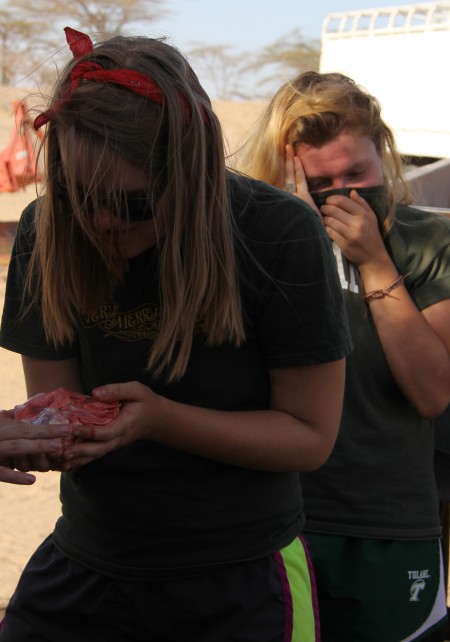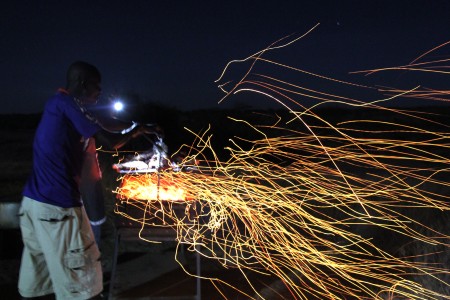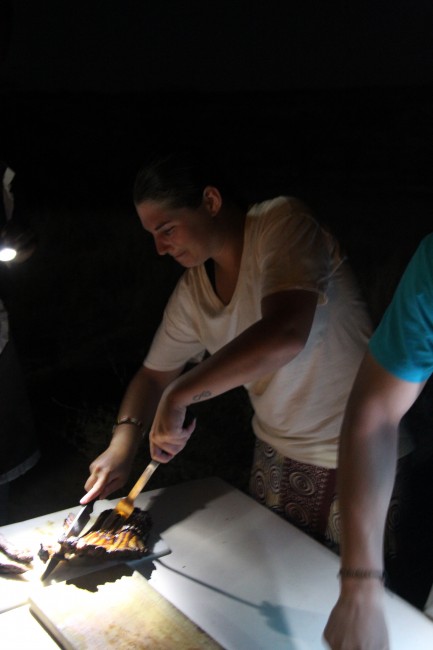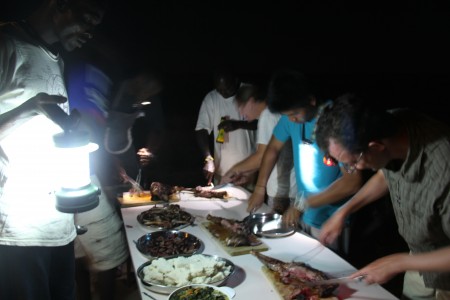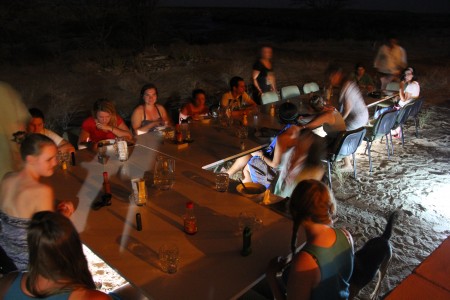The Turkana Basin Field school has switched timescales again. In ecology we were learning about the rapid impact modern humans are having on our environment, particularly in the Turkana Basin. In Geology we stepped way back to take a longer view of the basin’s evolution, starting with the Cretaceous rocks of the Basin (about 70 million years old) and tracing the roots of the modern lake through the evolution of the Omo River and Great Rift.
In our Archaeology module, Dr. Alison Brooks is taking us through the last 2.6 million years of geological history. This date marks the beginning of the archaeological record (for the time being) when the earliest stone tools start to turn up in sediments along with the remains of our ancient bipedal ancestors and the extinct elephants, giraffes and dirk-toothed cats they shared the landscape with.
Dr. Brooks is a professor at George Washington University in Washington, D.C. and a researcher with the Smithsonian. Her research has taken her from prehistoric France to the Kalahari Desert. The Kalahari project combined observation and interviews with the Khoisan – or “bushmen” – who are among the last hunter-gatherers left in Africa. This means Dr. Brooks and her family speak one of the click language of the Khoisan fluently.
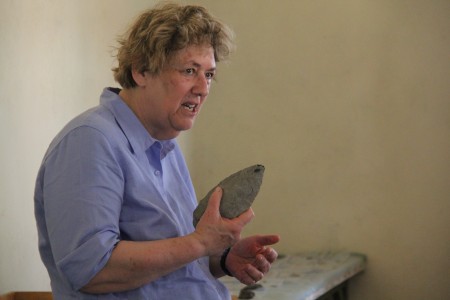
Dr. Brooks demonstrates how to recognize early stone tool industries. Here Dr. Brooks is holding one of the most popular tools ever crafted by human hands: The Achulean hand axe.
Knowledge of modern hunter-gatherer survival strategies and behavior helped Dr. Brooks and her collaborators understand the context of their ancient archaeological sites including clues to identifying ancient hunting blinds and signs of a camp. Armed with the search image for quality foraging sites and camping sites, the students were tasked with mapping likely places to make a living as a hunter-gatherer near TBI.
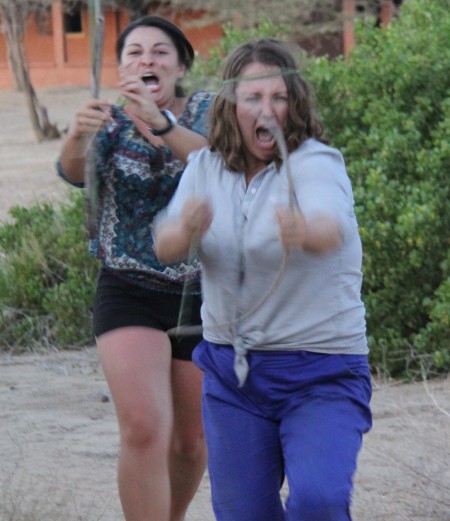
Maegan and Rosie found an ideal campsite near TBI...and went native in the compound. They'd probably make a solid, if belligerent, go at living on the banks of the Turkwel.
The Turkana Basin is the cradle of archaeology, with the oldest stone tools found in the rocks surrounding Lake Turkana. These earliest tools aren’t much to look at. They are basically flakes chipped off hard rocks such as rhyolite and basalt that were used without much reshaping after they flaked off a core. This early type of flaked stone tool kit is called an “Oldowan” tool or flake.
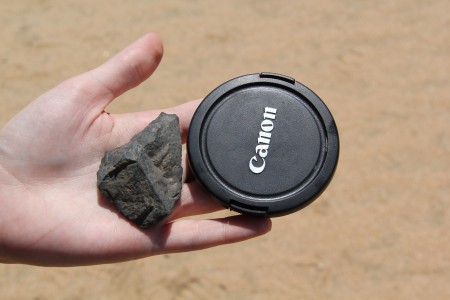
A basic Oldowan-style flake of basalt. It isn't too complicated, but it could be used to hack through a hide, bone, or wood. It also doesn't have to be ancient. Just because people develop more sophisticated technologies, all the old ways aren't necessarily dropped (you're welcome grandpa). This is still a perfectly legitimate tool for making a living in the Turkana Basin.
While an Oldowan tool may not look impressive, it represents the earliest preserved evidence that our bipedal ancestors could see something that wasn’t very useful (a big chunk of rock) and imagine how to make it into something that would help them access new resources such as meat and hide. This is the best evidence we have for an evolving sense of planning, creativity, and innovation in our lineage.
For a million years, this was our tool kit as far as the archaeological record can tell us. There may have been wood or animal-skin tools but they don’t preserve as well as the flakes of stone and chipped cobbles that crop up all over the Basin.
The next step in the evolution of tools came with the development of the “Achulean” tool kit. Hominids got more sophisticated. Instead of chipping flakes from a core and leaving it at that, they started working with the flakes, making more controlled blades as well as large, hand-sized cleavers and the classic “hand ax.” The tear-dropped-shaped tool is shaped on both sides and tapers to a point with a sharpened edge around the outside…and no one really know what it’s for. For a million years, this was the most common, complicated tool humans made from Africa to Indonesia. It was apparently the iPhone of its day. Everyone needed one.
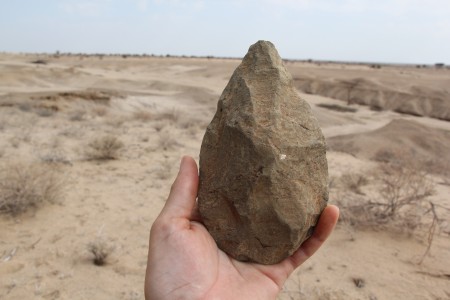
An Achulean Hand Axe near the site it was found. These objects can range from smaller than my palm to the size of my torso...and their function is till a hot topic in archaeology.
One of the problems with stone tools is they are never found gripped by hominid skeletons, so figuring out which species were making tools and using them is tough to sort out, though the Achulean kit seems to spread with Homo erectus, one of the first species in our genus Homo.
Dr. Brooks discussed these early experiments in lithic technology then asked each of the students to settle on to palm mats to try their hand at flaking tools as our ancestors did millions of years ago. We quickly learned it is not a simple task and our predecessors must have had sophisticated hand-eye coordination, lots of patience, and very sore thumbs.
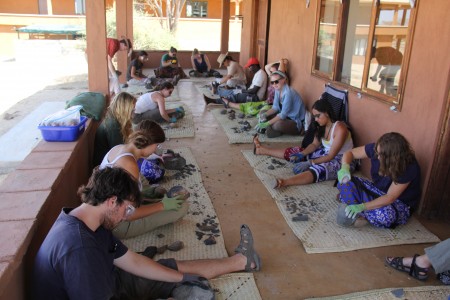
Everyone caught knapping. The challenge was to make a flake or tool that could actually be used to butcher a goat.
That said many of the students advanced pretty quickly from the Oldowan to the Achulean, trying their hand at making the most popular tool ever shaped by human hands: the hand ax. This was a pretty impressive step given the basalt nodules everyone was working with was pretty temperamental stuff and the hammer stones we were using flaked as easily as the basalt. We were then told there would be a goat roast in a week and we would be using the tools to test the effectiveness of our basalt knapping. Everyone worked harder to hone the edges of their tools.
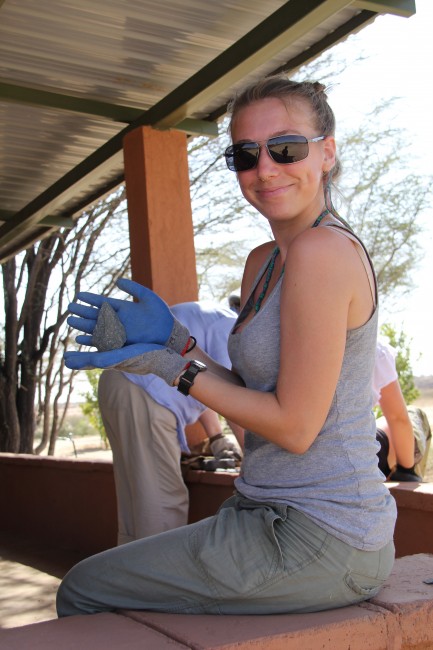
Bailey makes it to the Achulean. She covered 2 million years of technological innovation in 2 hours.
But before we could be successful hominid butchers, we needed to crack open some doum palm nuts. Doum palms grow everywhere there’s a hint more water than the open desert. They fill in along seasonal and flowing rivers. Their rind is sweet and we witnessed a Turkana woman pounding a nut at during our ecology farm visit to peel off the sweet husk.
But sometimes things get desperate and people need to get more than a sweet kick. They needed to eat the seed. After hurling rocks around and beating the palm nuts, we quickly learned the definition of a “fall-back food,” a resource people or animals only turn to in dire straits. Given our inability to crack many open quickly, it became clear most of us would not last long in a Turkana drought.
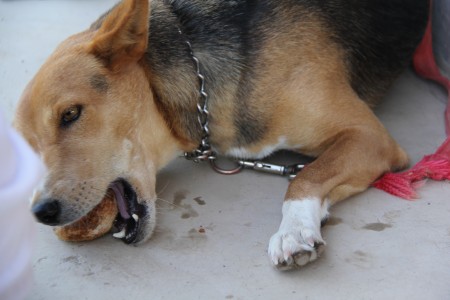
Maegan decided Tom might be a more effective tool for cracking nuts than stone. Tom was foiled, but not for lack of effort or enthusiasm.
We were more prepared for a barbeque, though. Earlier this week, the kitchen staff killed two goats and the students finally had the opportunity to put their stone flakes to use, slicing open the hide and skinning the animals as Old Stone Age people did for a few million years and as some hunter-gatherers did until the twentieth century. I think we were all a little surprised at how effective a simple basalt flake is at slicing through the muscle and hide of an adult goat. No wonder it took a while to get past this technology. It gets the job done.
After the animals were skinned, the staff deftly removed the internal organs and we had an impromptu discussion of the internal anatomy of ungulates. The multichambered stomach and long digestive tract were examined before moving on to more recognizable organs such as the liver, heart, and kidneys. Many of the students marveled at the similarities between the insides of the goats and what they know of human anatomy. Unfortunately, Oldowan flakes aren’t up to the task of a detailed goat dissection in the leaves.
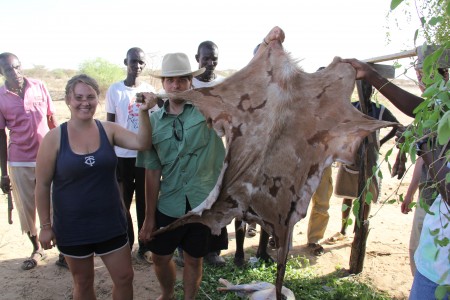
Rosie and Tim with the results of the class's labor. The flakes actually worked and we would get our feast.
Of course any goat butchering needs to be followed by a goat roast, which in turn leads to a goat feast. The tables we normally eat at under the cover of the mess hall were moved out under the stars by the barbeque and we enjoyed the fruits of our Paleolithic labor under the stars, just like Homo erectus. We may have developed more sophisticated technologies over the last 2.6+ million years, but we can’t improve on a feast under the Milky Way.

